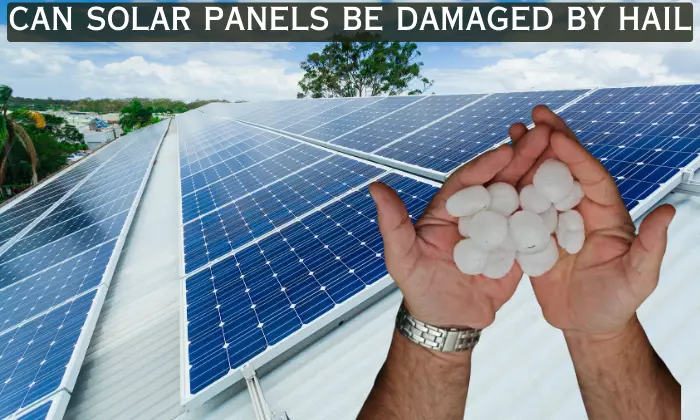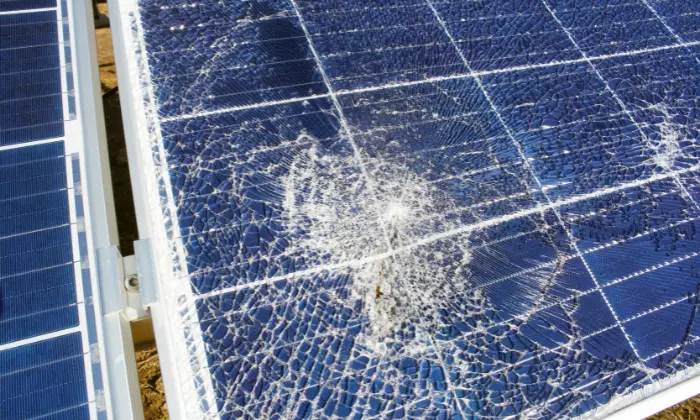Does Hail Damage Solar Panels?
Solar panels are incredibly durable and can withstand various weather conditions, including heavy rain and wind during most storms. While they are generally resilient against hail, severe hailstorms may pose a risk of damaging the panels.
The good news is that you have the power to protect your solar panels and your investment. By choosing the right panels and implementing additional safeguards, you can minimize the risk of damage to your solar system in the event of large hailstones.
Rather than accepting significant damage from storms, take proactive measures to prepare for the worst-case scenarios. This way, you may reduce the frequency of repairs or replacements needed for your solar panel system.
Understanding Hail Storms and Solar Panel Vulnerability

Discover the true potential of solar energy starting with the heart of your system: the photovoltaic (PV) panels. If you put these panels on your roof or in an open space, they will easily collect sunlight and turn it into power.
Concerned about their safety? Don’t be! With toughened glass surfaces, the panels withstand most weather conditions, including harsh hailstorms, without any damage.
Are Solar Panels Hail Resistant?
Solar panel manufacturers often claim that their modules can endure hailstones measuring up to 1 inch in diameter, suggesting that they can also withstand the impact of a golf ball. While solar panels are durable, it’s important to safeguard them during extreme weather. Although they’re resilient, severe hailstorms can sometimes push them to their limits.
Modern solar panels are very strong and can withstand hail as well as other harsh weather like heavy rain and high winds. A lot of solar panels are actually certified to resist winds as strong as a hurricane, which shows that they are strong and reliable even during big storms. Solar panel systems can keep making electricity safely and effectively because they are so strong. This gives people and companies peace of mind.
10 Best Ways to Protect Your Solar Panels From Hail Storm

A hailstone usually falls between 25 and 40 miles per hour and weighs about 0.26 ounces. When it hits something, it has an energy effect of about 1.26 joules. A solar array could be damaged by this force, which could lead to cracks or breaks in the panels, dents in the frames, or photovoltaic cells coming loose.
To safeguard your investment against the worst of nature’s fury, adopting precautionary measures right from the start is essential when purchasing panels. By doing so, you’ll maximize your solar energy system’s lifespan and confidently embrace a sustainable future. Act wisely, and choose solar!
Choosing the Right Solar Panel Location
Proper installation is vital to maximizing solar energy collection, but it also protects your panels from hail damage. Consider adjusting the orientation of your meetings to minimize hail impact during severe weather. Automated solar panel angle adjusters enable you to modify the angles, effectively reducing the impact of large hailstones. However, remember to readjust the panels to their optimal position for renewable energy collection after the storm passes.
High-Quality Solar Panel Installation
Proper installation plays a vital role in protecting residential solar panels and commercial solar installations from damage. Ensure that you hire a reputable and experienced solar panel installation company like Solar Earth Inc. A well-installed system will be more resilient to external forces, including hailstorms. Additionally, using high-quality mounting and racking systems will enhance the structural integrity of the installation.
Hail-Resistant Solar Panels
When purchasing solar panels, look for models specifically designed to withstand hailstorms. Hail-resistant panels are equipped with durable materials and enhanced protective layers that can mitigate the impact of hailstones. These panels are rigorously tested to meet industry standards and offer increased reliability during extreme weather events.
Spray on a Methacrylate Layer for Added Protection
Methacrylate, a cost-effective spray-on monomer, provides a protective layer for your solar panels. Unlike hardcovers, this solution allows your solar cells to receive and convert sunlight even after application. However, it is crucial to use the correct amount to ensure adequate protection. Avoid spraying methacrylate on the metal parts of the panel, as this can damage them and reduce their electrical conductivity.
Protect the Panels with Wire Mesh
A wire gauge mesh around the panels offers a protective covers from direct hail impact. This approach permits sunlight to penetrate while safeguarding against more giant hailstones. To achieve optimal protection, ensure the proper distribution of wire mesh—holes should be large enough for sunlight to pass through yet small enough to prevent significant hail damage.
Protective Hail Nets or Screens
Installing protective hail nets or solar arrays is another effective method to protect solar panels from hails or golf ball damage. These durable coverings act as a physical barrier, intercepting and dispersing the impact of hailstones. When choosing a hail net or mesh, ensure it is UV-resistant and designed to endure various weather conditions without compromising solar panel efficiency.
Impact-Resistant Panel Coatings
Applying impact-resistant coatings to the surface of solar panels can add an extra layer of protection. These coatings are designed to absorb and disperse the force of hailstones, reducing the risk of damage. Using coatings formulated explicitly for solar panels is essential to maintain transparency and efficiency.
Regularly Inspect Your Panels
Like small cracks on a car windshield, hailstones can exacerbate existing problems on cracked solar panels. Regularly inspect your solar array to identify damage and promptly address maintenance needs. While flexible solar panels may withstand hail storms better, rooftop systems using rigid panels risk compromised efficiency from just a damaged forum. Conduct visual inspections and perform maintenance to preempt any issues before they escalate.
Check Your Homeowner’s Insurance Policy
While manufacturer warranties typically do not cover hail damage, your standard homeowner’s insurance policy often does. Before filing a claim, carefully review your policy’s terms and conditions. Ensure you meet all requirements to avoid losing coverage due to technicalities. In the event of hail damage to rooftop solar panels, filing a claim through your homeowner’s insurance policy may be appropriate.
Follow Weather Forecasts Closely
Being prepared involves both having the necessary resources and knowing when to act. Keep a close eye on weather forecasts and track the movements of inclement weather approaching your area. Being aware of the impending storm will allow you to take preemptive measures, such as covering your panels and securing your property, to minimize potential damage.
By implementing these strategies, you can protect your solar panels from hail damage, ensuring they operate efficiently and generate renewable energy for years. Remember, proactive maintenance and protective measures are vital to safeguarding your solar investment and optimizing the benefits of clean energy.
Conclusion
Protecting your solar panels from hailstorm damage is essential to maximize their efficiency and lifespan. You can safeguard your solar investment by choosing the right location, installing hail-resistant panels, and implementing protective measures such as hail nets or coatings. Regular maintenance and inspections will help you detect any issues early on and maintain the optimal performance of your solar panel system.
Remember, investing in high-quality solar panels and protective measures, offered by Solar Earth Inc., is an investment in the future of clean and sustainable energy generation.
